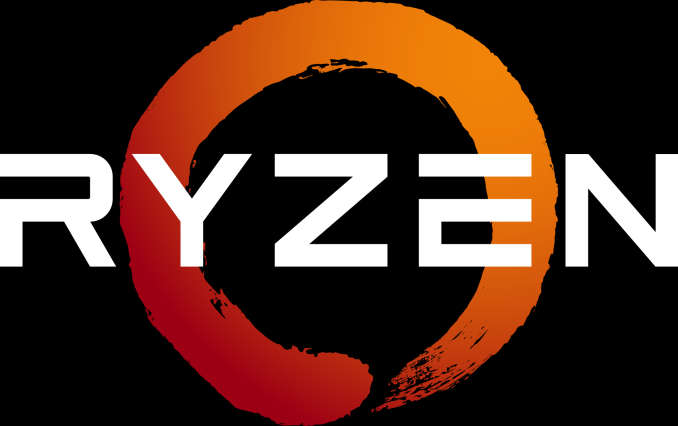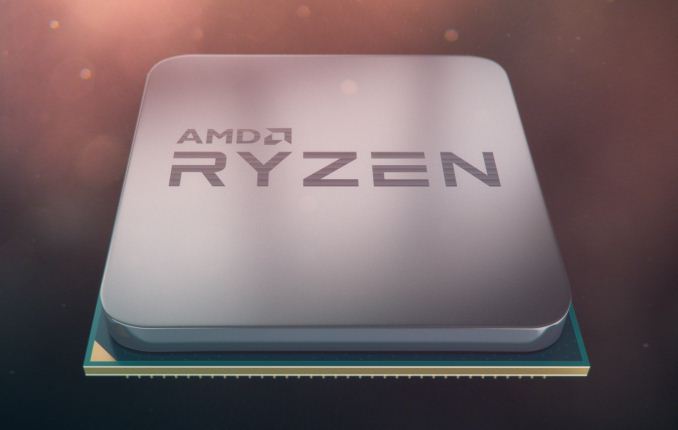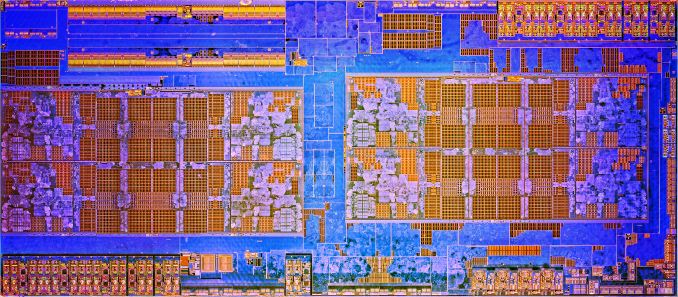AMD Launches Ryzen: 52% More IPC, Eight Cores for Under $330, Pre-order Today, On Sale March 2nd
by Ian Cutress on February 22, 2017 9:00 AM EST
The biggest x86 launch for AMD in five years is today: Ryzen is here. As always before a major launch, AMD gives a ‘Tech Day’ for relevant press and analysts, and through this event AMD’s CEO, Dr. Lisa Su lifted the lid on one of the most anticipated products in the semiconductor industry. AMD knows how to control the level of enthusiasm for its fans, and today is the end result, with processors going on pre-order from major retailers today at 1pm EST, ready for a general hard launch on March 2nd.
In a similar vein to launches of recent smartphones, AMD is doing a staggered announcement/launch with the products on their new microarchitecture. Where Samsung/Apple might give all the details for a product a few weeks before it’s available to buy, today on February 22nd marks the day where AMD is giving consumers information about Ryzen, and specifically the Ryzen 7 family of eight-core products. All the information today is from AMD, and AMD’s internal testing, and pre-orders also start from today for users ready to put down their money for a launch day part. Reviews of the CPUs, as well as when the CPUs will ship to customers, is on March 2nd. This also happens to be right in the middle of two annual shows, Game Developer Conference (GDC) and Mobile World Congress (MWC), making the time between receiving pre-launch samples and being able to provide independent verification of AMD’s performance claims relatively frantic. We’ll do our best!
The Ryzen Family
With a new processor launch, naming the parts and positioning them within the market is critical. So with Ryzen, the processor stack will be split into three based on performance and price: Ryzen 7 at the high end, Ryzen 5 in the middle, and Ryzen 3 for more price-conscious consumers. Both Ryzen 5 and Ryzen 3 are set to be launched later, and Ryzen 7 is the first portion of the family to be released.
Ryzen 7 will have three CPUs to start, all having eight cores and supporting simultaneous multi-threading:
- Ryzen 7 1800X: 8C/16T, 3.6 GHz base, 4.0 GHz turbo, 95W, $499
- Ryzen 7 1700X: 8C/16T, 3.4 GHz base, 3.8 GHz turbo, 95W, $399
- Ryzen 7 1700: 8C/16T, 3.0 GHz base, 3.7 GHz turbo, $329
Ryzen 7 1800X will be the high-end part, featuring a base clock of 3.6 GHz and a turbo of 4.0 GHz, within a TDP of 95W, and for $499. Next to this is Ryzen 7 1700X, launching at $399, with a base/turbo of 3.4/3.8 GHz. The final part for the launch is the Ryzen 7 1700, providing eight cores and sixteen threads for $329 at 3.0/3.7 GHz frequencies.
Processors will initially be available for pre-order from 185 retailers and OEMs worldwide, either as individual parts or pre-built systems.
What, not 40% IPC? 52% IPC??
Enthusiasts and analysts use the term IPC, or ‘Instructions Per Clock’, as a measure of how much the underlying microarchitecture improves from generation to generation. Two decades ago, a good design on a smaller node could net a healthy double-digit gain, whereas in recent years 5-10% gain has become the norm. When AMD initially announced that the new Zen microarchitecture they were developing was aiming for a 40% IPC gain, despite the low IPC they were starting from, users remained skeptical. AMD rehired Jim Keller to work alongside long-term AMD architect Mike Clark and produce a team with several goals in mind: high-performance x86, simultaneous multithreading, and a product to be relevant in the computing, PC, server and mobile space again. So despite this, 40% IPC always seemed a somewhat lofty goal, because Bulldozer was so underwhelming, and despite this low starting point. For the Ryzen launch today, AMD is stating that the final result of that goal is a 52% gain in IPC.
This is something we will need to test in due course!
The Ryzen Silicon, and the Future
AMD pointed out that the new 8-core silicon design runs 4.8 billion transistors and features 200m of wiring. Through previous announcements we’ve examined parts of the microarchitecture including cache sizes, threading, front-end/back-end design, and so on.
AMD Zen Microarchiture Part 2: Extracting Instruction-Level Parallelism
AMD Gives More Zen Details: Ryzen, 3.4 GHz+, NVMe, Neural Net Prediction, & 25 MHz Boost Steps
AMD’s CEO was keen to point out that this is a from-scratch design for AMD, using the knowledge gained from features developed for previous products but ultimately under the hood it looks like ‘a typical x86 high-performance core’, with AMD-specific features and tweaks. We were told that AMD’s roadmap extends into the multi-year range, so while the focus for 2017 will be on this family of products, back at HQ the next two generations are in various stages of development.
BENCHMARKS PLEASE
So despite the 82+ motherboards going to be available, 19 initial PC system builders moving into 200+ through the first half of 2017, the big question on everyone’s lips is how exactly does it perform?
Well, AMD gave us the following numbers:
AMD's benchmarks showed that the top Ryzen 7 1800X, compared to the 8-core Intel Core i7-6900K, both at out-of-the-box frequencies, gives an identical score on the single threaded test and a +9% in the multi-threaded test. AMD put this down to the way their multi-threading works over the Intel design. Also, the fact that the 1800X is half of the price of the i7-6900K.
In a similar vein, again with the Cinebench 15 multi-threaded test, the Ryzen 7 1700X scores over and above the Core i7-6800K (its price competition) and higher than the Core i7-6900K which costs 2.5 times as much.
We’ll tell you what our benchmarks say, with official retail processors. But you will have to wait until March 2nd. Sorry.





















386 Comments
View All Comments
Outlander_04 - Thursday, February 23, 2017 - link
And if we counted years rather than design cycles?Outlander_04 - Thursday, February 23, 2017 - link
So far the benches are cherry picked to use all cores in parallel work loads.I expect that they processors may fall behind in gaming, and especially games that do not multithread well , but the difference will not be great.
The extra cores will be a great help to anyone streaming thats for sure.
Two problems so far as I see it . Where are the hexcores? Where are the mATX boards build for overclocking? May they come soon
fanofanand - Thursday, February 23, 2017 - link
Hexacores are part of their r5 lineup and undercut Intel as much as the 7 vs 7s.Outlander_04 - Thursday, February 23, 2017 - link
I know.But when will I be able to buy one?
mapesdhs - Thursday, February 23, 2017 - link
HOOfan 1 wrote:> Buh bye like when the Athlon 64 X2 processors were superior to the Pentium 4 D processors?
Years ago I was considering building a new system based on the E8400, but it was expensive and I couldn't find a S775 board that also had proper PCIX. Then AMD did a huge discount the Athlon64 X2, so I bought a 6000+ and a relevant AM2 board to go with it (ASUS M2N32 WS Pro). This was great at the time, but I got burned by the lack of BIOS updates (can't use Ph2, ASUS just wasn't interested, whereas Asrock released a Ph2 update even for its budget AM2 boards).
Sometimes what can seem a good thing because of a pricing issue can end up being a pain in the butt. I hope we don't see this sort of thing happen again. The industry is full of all sorts of niggles like this, especially BIOS issues. I love the ASUS M4E, runs any 2700K at 5GHz no problem, but there's something wrong with the NEC USB3 controller which has never been fixed. Atm I'm trying to get a simple PCI capture card working on a Gigabyte Z68 board; works on an Asrock board, but makes the Gigabyte do an instant power-off. I could list endless examples just from my own experiences, I'm sure anyone else here could do the same.
We as techy consumers get taken in way too much by specs, benchmarks, etc., when in reality all sorts of practical issues can make a right mess of the genuine usefulness of many tech products, from dodgy drivers to hw compatibility problems that shouldn't happen if product makers were complying with official interface specs. And now we have deliberate OS lockout; can I run Win7 on Ryzen? Consumer tech is not tested properly, updates are sketchy, bugs are not dealt with, and even pro items often don't receive the support their pricing should command.
If you want a perfect example of this, ask any tech site to do a comparative review of a new CPU/mbd combo using the mbd fitted with maximum RAM. I had a hell of a time getting an X79 board to work with 64GB when they first came out, the manufacturer just hadn't bothered sorting out the stability issues for such a config, the auto/defaults were just not good enough. Why are they allowed to get away with claiming a board supports some maximum RAM when in reality it simply doesn't work?
There's a lot of talk here about AMD shaking things up, an understandable comments about the potential appeal of Ryzen to professionals. This is true, but don't leap too fast. Before buying an 1800X for any pro task, find a review site that's tested it with max RAM, ie. 64GB.
Ian.
iranterres - Thursday, February 23, 2017 - link
I don't think AMD will defeat Intel in benchmarks that much, but I'm sure the competition is back and Intel will be pressed once again.fanofanand - Thursday, February 23, 2017 - link
This is so true, they slap the highest numbers on the box that they can, but it's more similar to someone who has overclocked the bejeesus out of their CPU and are able to get it to post so they think that's their oc. 5 seconds into prime it crashes but they have they cpuz screenshot. I have had boards that couldn't even handle the RAM speed it claimed unless it was less than half of the stated max capacity. I don't want to know what it can do in a 1% edge case I want to know what it can handle day in and day out without artifacting and corrupting.mapesdhs - Tuesday, February 28, 2017 - link
I have a Kingston DDR3/2GHz kit that simply will not run at its rated speed (tried various boards), whereas a GSkill or Mushkin kit works fine.And pro tasks are demanding in a way that no tech site review benchmark can convey (not helped by many pro benchmarks being very contrived). In 2013 I built a 4.8GHz 3930K triple-580 system with 64GB/2133 RAM that passed every benchmark and test I could throw at it (toms sent me their test suite), handled all the 3D tests aswell, both gamer and pro (Viewperf, etc.) But trying something for real in After Effects, doing a render that gobbled 40GB RAM (so hammering the entire system), it didn't crash but there were artefacts in the render output (possibly something an ECC setup would prevent); reducing the clock to 4.7 resolved the issue. Even then, to get it stable with 64GB required a lot of info requests to ASUS, specific settings needed to handle the current loading, etc., and I was using a top-end board supposedly specifically designed to cope with such high-end specs (P9X79 WS). Standard oc profiling assumes far less RAM is present.
If the same sort of problems occur with Ryzen, I just hope the mbd vendors will get their BIOS updates out fast, otherwise there's a risk people will blame AMD rather than the market pressures and/or lazy testing that allows imperfect products to come to market. Nobody would tolerate this sort of thing if it was a car (oops, gone over 70mph, the wheels fall off, sorry!), but somehow with computer tech it's become the norm to expect faults. The loss of productivity globally from this must be staggering, both hw and sw related.
Ian.
fanofanand - Thursday, February 23, 2017 - link
I thought Feb 28th was the embargo lift day?sharath.naik - Thursday, February 23, 2017 - link
Ok, lets face it, kaby-lake still holds a 15% performance advantage, and the intel can boost much higher. But now for the good bits, the TDP is probably the most interesting info (again taken with a grain of salt give AMD's way of measuring TDP), if this holds true then intel may have a serious competition in the server space. As it will allow AMD to ram in much higher number of cores than what intel currently can(22 core's for >5000$). I am looking forward to that because at that point AMD is simply a better buy given intel keeps changing the socket every generation, adding to the cost of everything